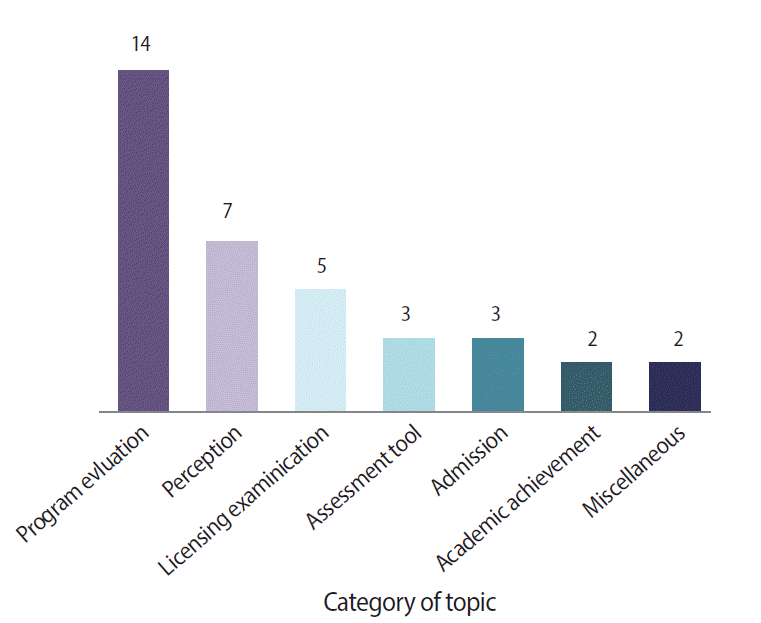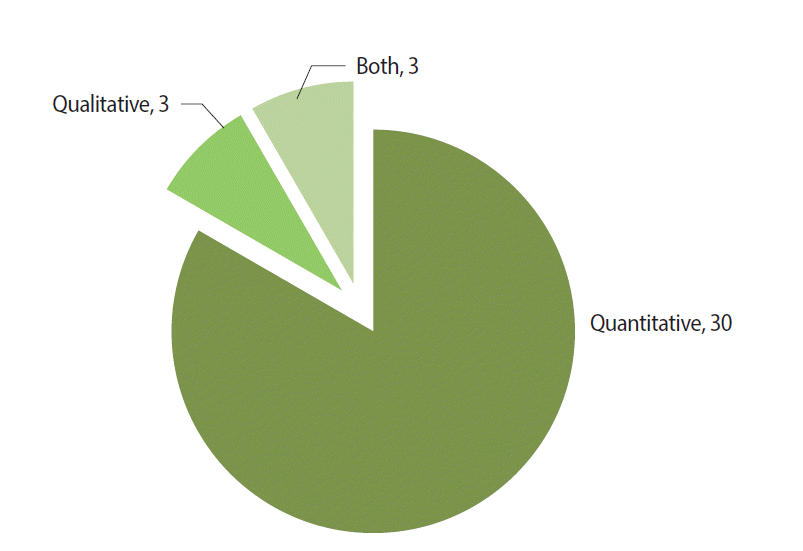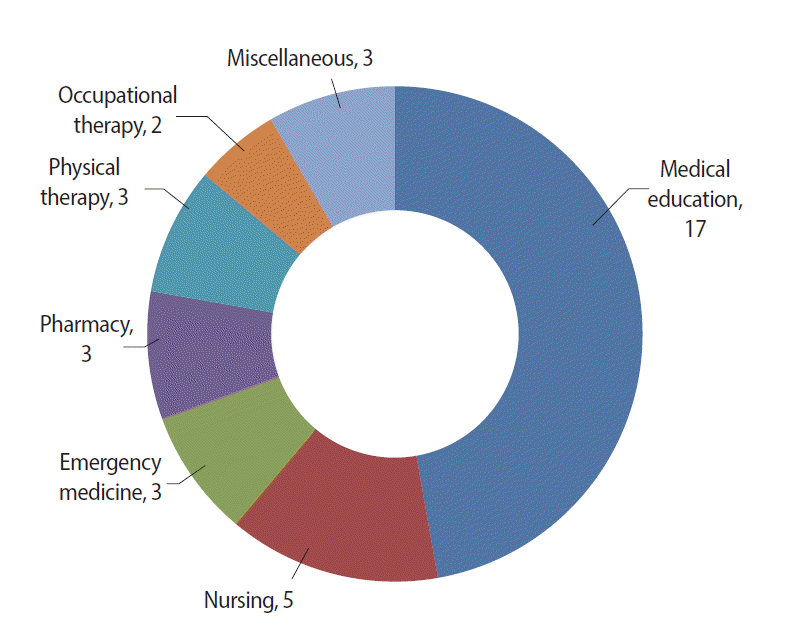As the associate editor of Journal of Educational Evaluation for Health Professions, I was pleased to see the remarkable maintenance in its quality and its embrace of the diversity of contents and authors from all over the world this year. Compared with 2015, the number of papers that were published decreased from 58 to 46. Despite the rise in the number of manuscripts that were submitted, this decline in publications was intended to elevate the quality of the journal to an even higher standard, entailing an increase in the rejection rate of submissions. Out of 46 papers, there were 23 research papers, 9 brief reports, 4 technical reports, 6 editorials, and 2 opinions and reviews each.
When the journal was first published in 2004, the papers were solely from Korean authors, but 22 countries made contributions in 2015 [1], and this year, 31 did so, including Brazil, Bulgaria, Croatia, Egypt, Estonia, Ethiopia, Finland, Iceland, Iran, Laos, Nicaragua, and Saudi Arabia. The number of Korean papers decreased to 10 (21.7%). This meant that we had a tremendous opportunity to understand the education of health care from a wide variety of institutions and regions.
In total, there were 36 research papers and reports. As shown in Fig. 1, the most frequently represented discipline was medical education (48.6%), followed by nursing (14.3%), emergency medicine (8.6%), pharmacy (8.6%), and physical therapy (8.6%). The number of articles that were published by research subject was analyzed (Fig. 2), in which most studies dealt with medical students (44.4%) and, to a lesser extent, involved residents (13.9%) and physicians (5.6%). In the field of nursing, there were 3 papers on nursing students (8.3%) and 3 that included nurses (8.3%). Pharmacy students were subjects in 3 studies, versus pharmacists in 2. Other research subjects consisted of students and professionals in various disciplines, including dental students, occupational students, physical therapy students, emergency medical technicians, and rural health professionals.
The number of articles that were published with regard to research content is shown in Fig. 3. Most studies were about program evaluation (36.1%), followed by papers on perception (19.4%), licensing examinations (13.9%), assessment tools (8.3%), admissions (8.3%), and academic achievement (5.6%).
If we examine the methods that were used for each study that was published in 2016, 83% of papers used quantitative analysis, whereas only 9% used a qualitative method; 8% of papers used both methods (Fig. 4). But, the articles that did use both quantitative and qualitative methods were all brief reports that performed a simple analysis of the interviews or questionnaires. Eighteen papers dealt with differences in data, 5 articles used correlation analysis, and there were 2 factor analyses and 2 meta-analyses. Nine papers used t-test, 4 used regression and chi-square, 3 used analysis of variance, and there were 4 pre- and post-tests.
To sum up, I expect more original and research papers next year. It would be wonderful to see more articles submitted from various regions throughout the world other than the United States and Korea.
Regarding the academic discipline of the paper, it seems appropriate to see many reports on subjects at the student level, but most papers were in the medical field. More papers from other disciplines other than medicine, nursing, and pharmacy are welcome. It was interesting to see papers using a variety of assessment methods—from simple descriptive analysis to regression. The two-factor analysis [2,3] and meta-analysis papers [4,5] added to this variety, which was encouraging. But, it is clear that the majority of articles is inclined toward the use of qualitative methods. All of us know that qualitative methods can generate significant supplementary results to a quantitative analysis, but using a qualitative method alone can also yield valuable findings.
Although most papers focused on the evaluation of programs, it was nice to see a range of content on perception, licensing examinations, assessment tools, and academic achievement. Recently, I was delighted to see a paper that assessed the cost-effectiveness of a program [6]. When developing a new program or curriculum, the last step before receiving feedback can be to evaluate the cost-effectiveness of education. This is a very important subject to which we need to give more attention, because effective medical education relies strongly on manpower and financial support. I would like to conclude that the ideas that have been shared by the authors from all over the world this year have made 2016 a fruitful one.
Article information
-
Conflict of interest
No potential conflict of interest relevant to this article was reported.
Supplementary material
Supplement 1. Raw data file of the analysis of the research articles and brief reports published in 2016 issues of Journal of Educational Evaluation for Health Professions.
jeehp-13-46-supple.xlsx
Fig. 1.Number of articles published in 2016 by discipline.

Fig. 2.Number of articles published in 2016 by research subject.

Fig. 3.Number of articles published in 2016 by research content.

Fig. 4.Type of method used in papers published in 2016.

References
- 1. Huh S. How much is Journal of Educational Evaluation for Health Professions promoted based on journal metrics? J Educ Eval Health Prof 2015;12:57. https://doi.org/10.3352/jeehp.2015.12.57 ArticlePubMedPMCPDF
- 2. Yuen HK, Azuero A, Lackey KW, Brown NS, Shrestha S. Construct validity test of evaluation tool for professional behaviors of entry-level occupational therapy students in the United States. J Educ Eval Health Prof 2016;13:22. https://doi.org/10.3352/jeehp.2016.13.22 ArticlePubMedPMCPDF
- 3. Nation LM, Tweddell S, Rutter P. The applicability of a validated team-based learning student assessment instrument to assess United Kingdom pharmacy students’ attitude toward team-based learning. J Educ Eval Health Prof 2016;13:30. https://doi.org/10.3352/jeehp.2016.13.30 ArticlePubMedPMCPDF
- 4. Kyriakoulis K, Patelarou A, Laliotis A, Wan AC, Matalliotakis M, Tsiou C, Patelarou E. Educational strategies for teaching evidence-based practice to undergraduate health students: systematic review. J Educ Eval Health Prof 2016;13:34. https://doi.org/10.3352/jeehp.2016.13.34 ArticlePubMedPMCPDF
- 5. Cook CJ, Cook CE, Hilton TN. Does emotional intelligence influence success during medical school admissions and program matriculation?: a systematic review. J Educ Eval Health Prof 2016;13:40. https://doi.org/10.3352/jeehp.2016.13.40 ArticlePubMedPMCPDF
- 6. Isaranuwatchai W, Alam F, Hoch J, Boet S. A cost-effectiveness analysis of self-debriefing versus instructor debriefing for simulated crises in perioperative medicine. J Educ Eval Health Prof 2016 Dec 26 https://doi.org/10.3352/jeehp.2016.13.44 ArticlePubMedPMCPDF
Citations
Citations to this article as recorded by






 KHPLEI
KHPLEI





 PubReader
PubReader ePub Link
ePub Link Cite
Cite





